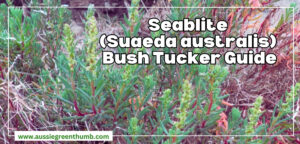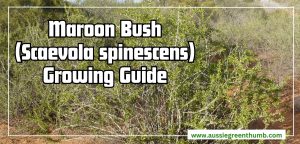There are over 250 known species in the genus Camellia, but the one most people think of is Camellia japonica. Arguably one of the most important genera in the world, Camellia is responsible for billions of dollars worth of global trade each year in tea. However, the plant usually used for tea is Camellia sinensis.
Camellia japonica is the more garden-friendly and much more ornamental choice. There are some similarities between Camellia japonica and the other common garden camellia, C. sasanqua, but C. japonica has significantly larger flowers and offers more bang for your buck as gardeners and garden designers.
More...
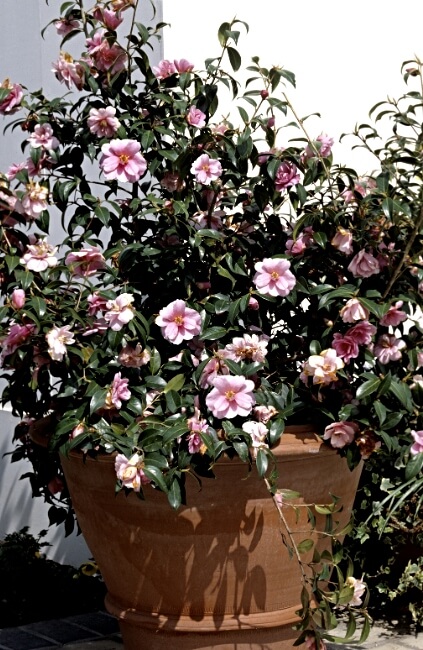
Family: | Theaceae |
|---|---|
Genus: | Camellia |
Species: | C. japonica |
Common names: | Camellia, Japanese Camellia, Common Camellia |
Origin: | China |
Location: | Outdoor |
Type: | Small trees or shrubs |
Growth: | Up to 10m tall |
Sun requirements: | Part shade preferred |
Foliage colour: | Green |
Flower colour: | Pink, red white (varies by cultivar) |
Flowering: | Winter |
Edible parts: | Leaves are edible, but not commonly used |
Maintenance level: | Medium |
Poisonous for pets: | Pet safe |
What is Camellia japonica?
Camellia japonica is a widely popular garden shrub. Its versatility and variations have proved to be so successful that there are literally thousands of cultivars within the Camellia japonica species each with their own characteristics.
However, they all have dark glossy leaves that look polished, with tight pointed buds. In my experience, there is no cultivar or hybrid that disappoints. When it comes to flowering the entire species is adorned, and the floor beneath Camellia japonica is just as colourful as the plant.
Despite its name, Camellia japonica is native to China not Japan. Its history dates as far back as the Song Dynasty where some fifteen cultivars are recorded in Chinese literature.
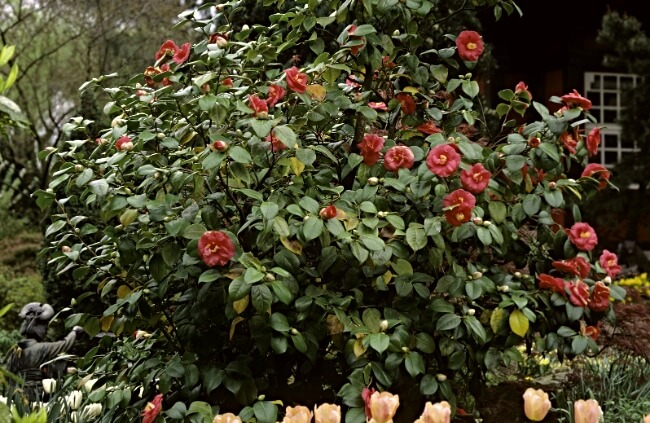
What is Japanese Camellia's Natural Habitat?
Camellia japonica was later introduced to Japan from China and is found naturalising in high-altitude forests. Mostly found in larger numbers in eastern and Southern Asia. Generally, they prefer a shady or semi-shaded area which gives them their unique selling point.
They are fairly adaptable but want to be in slightly acidic soil where possible, so are found thriving naturally within forests where the leaf litter creates a perfect growing medium and fertiliser.
Although they like shade, Camellia japonica does need some good light to thrive and form flowering buds, but shade is crucial as it protects both flowers and leaves from bright midday sun. This is why you’ll find camellia colonising the somewhat unlikely space under the canopy of forest trees.
Common Uses for Camellia japonica
Although you can’t use Camellia japonica to make a proper cup of tea, it has other beneficial uses. Within Japan, Camellia japonica is known to have been used medicinally as an anti-inflammatory.
It is thought that both the leaves and flowers of camellias have antioxidant and anti-viral properties. Therefore even C. japonica has been made into teas as flowers themselves are edible, traditionally used dried in Asian cuisine or as an attractive garnish.
Camellia japonica oil is used to treat burns and scalds on the skin. This oil is called Tsubaki and is extracted from the seed. It is still a very popular beauty enhancement treatment. Tsubaki oil is also found to be beneficial when used in hair conditioning.
Best Camellia japonica Cultivars to Grow in Australia
There are, literally, thousands of cultivated varieties and hybridised plants that come from Camellia japonica. Just forty-three have received the RHS Award of Garden Merit (RHS AGM), which notes them as suitable, manageable and attractive garden plants for gardeners around the world.
All 43 RHS AGM cultivars are listed below, providing an outline of the most attractive Camellia japonica and C. japonica hybrids to grow:
- C. japonica ‘Grand Prix’
- C. japonica ‘Grand Slam’
- C. japonica ‘Guilio Nuccio’
- C. japonica ‘Hagoromo’
- C. japonica ‘Hakurakuten’
- C. japonica ‘Joseph Pfingstl’
- C. japonica ‘Jupiter’
- C. japonica ‘Konronkoku’
- C. japonica ‘Lavinia Maggi’
- C. japonica ‘Mars’
- C. japonica ‘Masayoshi’
- C. japonica ‘Mercury’
- C. japonica ‘Nobilissima’
- C. japonica ‘Nuccio's Gem’
- C. japonica ‘Nuccio's Jewel’
- C. japonica ‘R.L. Wheeler’
- C. japonica × reticulata ‘Royalty’
- C. japonica ‘San Dimas’
- C. japonica × reticulata ‘Tom Knudsen’
- C. japonica ‘Sylva’
- C. japonica ‘Tricolor’
How to Grow Camellia japonica
Camellia japonica generally aren’t too demanding to grow. Given the right conditions, these showy shrubs will reward you with years of beauty. Although slow to grow they are very long-lived so, more often than not, you’ll inherit one when you buy a home with a garden.


Get Your Free Guide:
Master Growing Australian Natives eBook
A Must Have Complete Guide for Every Australian Garden
Get Your Free Guide:
Master Growing Australian Natives eBook
A Must Have Complete Guide for Every Australian Garden

Optimal Conditions for Japanese Camellia
When choosing the best position to plant your Camellia japonica, consider its preference for shade and slightly acidic soil. If you don't have these requirements it may be beneficial to plant your camellia in a pot where you can tailor its care.
Soil & Drainage
Using a slightly acidic soil or ericaceous peat-free compost will ensure your camellia is happy, it’s best when given a pH of around 6.0 - 6.5. Adding drainage to either the pot or planting hole will allow for a good free-draining root run as your camellia grows.
They hate to have their roots sitting in water for prolonged periods.
Light & Temperature
A garden with established trees can often pose a challenge when it comes to underplanting, however this is the ideal spot for your camellia. Bear in mind how the light travels as a prime spot would be somewhere where it can get a touch of dappled, filtered sunshine.
Shelter
The benefit of growing camellia in a pot is that when harsh weather is on the way, your camellia can find shelter, maybe within a greenhouse or beneath the closest canopy. Anywhere situated away from the harshest winds, or hottest midday sun will suit your Camellia japonica.
Planting Camellia japonica
Consider the overall size your Camellia japonica will become. Given the right care, some can develop into giant specimens. Surrounding flora may become swamped or may not like an ericaceous environment.
Knowing if your camellia has a grafted rootstock and where that graft is can help with planting. You’ll want to plant your camellia with the graft above the ground so that the above graft stock won’t root.
How to Propagate Camellia japonica
Propagating Camellia japonica from Seeds
Camellia japonica can be propagated from seed. However, seedlings may not come true to the parent plant. The flowers will generally be cross-pollinated and produce a different colour or flower shape.
To sow your own Camellia japonica (and potentially experiment with hybridisation), you’ll need a loose but moisture-retentive compost and a fairly large pot (about 20cm wide), as the seedlings don’t like being moved.
Plant seeds straight into the compost, and cover with 1cm of soil. Plant in late autumn or early spring during cooler weather, and keep the compost moist but never sodden.
It can take up to a year for germination, but if you’re lucky they can germinate in as little as a month.
Propagating Camellia japonica from Cuttings
Cuttings are a reliable way to propagate Camellia japonica, this can be done with semi-ripe or hardwood cuttings, layering and grafting.
Semi-ripe and hardwood cuttings will root more easily if slightly wounded or damaged by stripping a few centimetres of bark at the base of the cutting and dipping in rooting hormone.
When taking cuttings, bear in mind whether your camellia has a graft. Grafts may affect how the cutting will develop - e.g. If the rootstock was used for size control, you may end up growing a much larger cultivar.
Camellia can even root in just water alone. However, cuttings can be slow to strike and form roots, it can be a few months before you see any signs of success.
How to Care for Camellia japonica
Watering is important for your Camellia japonica. This isn’t just for overall health, it has direct visual benefits. As the flower buds start to develop in mid-summer, in preparation for next year's flowers. So, during the drier months, it’s crucial to keep plants well watered when camellia is forming next year's flowering buds. Lack of water will result in sparse flowering the following year.
As well as watering, there are some other helpful tips below, including how to mulch camellia, and what with.
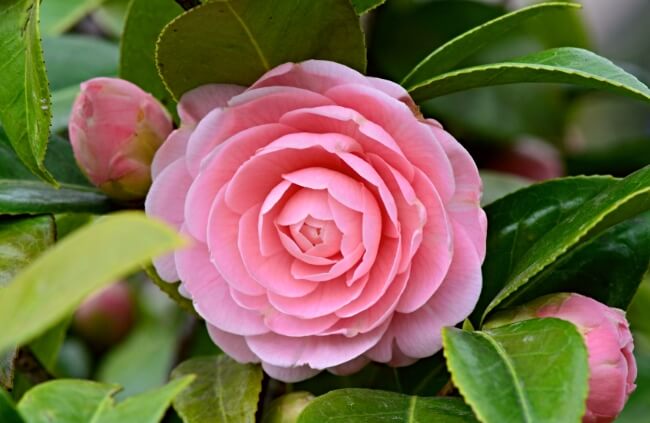
Mulching Japanese Camellia
At least every other year, camellia should be given a generous 5cm mulch of organic compost or leaf mould. Rotted horse or cow manure will work well too - but once every three or four years will be sufficient to maintain the health of the soil around the base of the plant.
Avoid touching the trunk of Camellia japonica during this process. Leave a gap of 10cm around the trunk to prevent fungal problems from passing from the damp material.
This is equally important for Camellia japonica planted in pots. Mulching helps to maintain the soil health and reduces how often your plants need repotting. It will also replace spent compost, which will start to deplete, leaving gaps at the top of your pots.
Feeding and Fertilising Camellia japonica
In summer, while watering Camellia japonica, there are many ways to boost its overall health. My grandparents used to swear by leaving all of their old tea bags on the ground beneath their camellia, and they had the most floriferous shrub I’ve ever seen.
Other homemade fertilisers for camellia include coffee ground, banana peels and citrus peels.
But, in reality, any slow-release granular fertiliser, or poultry manure pellets will do the trick and can be done once a month in summer.
Liquid feeds can be given in the form of balanced nutrients. Standard tomato fertiliser or any 10-10-10 fertiliser can be added to water, and liquid seaweed will help to maintain soil health. Only apply liquid feeds once a month during summer - not during spring, autumn or winter.
Pruning Camellia japonica
Your Camellia japonica doesn’t need a great deal of pruning, but it will definitely benefit from a regular inspection removing dead, diseased or dying branches. If you want to create a specific shape with your camellia such as a ‘standard’, this requires some tending. Any pruning should be done straight after flowering so as not to cut away any developing buds or next year.
Maybe the most important pruning job of all, deadheading. Camellias will happily drop their old flowers and make way for new, easily seen littered on the ground below providing their own mulch. If you want to keep your camellia tidy, you can deadhead these old flowers at your leisure. Another maybe more liberating way is to grab a strong trunk and give it a shake, the old material will fall right off.
Camellia is also suitable as a small tree, if your cultivar is inclined to grow tall, crown lifting will expose the trunk and give a beautiful small tree aesthetic.
Common Japanese Camellia Pests and Diseases
Camellia japonica is typically quite adaptable and tolerant when troubled by pests or an infestation. There are some things to look out for that can help maintain a healthy shrub, but keeping your garden in harmony by inviting wildlife in and planting a variety of pollinator and bird-friendly plants will usually help to manage most pests (and by extension, diseases).
New camellia buds can occasionally have ants, these are causing no harm and are simply opportunists getting a sweet treat from the sugary sap extruding from the tight flower buds.
Scale insects can cause problems with camellia too. Small infestations may not need to be treated but noticeable damage will show as mottled leaves with a loss of colour and lustre. The best defence is always a strong offence, providing beneficial predators in a diverse garden will eradicate your need to use any chemicals.
Camellia can develop yellowing of the leaves. This can be an indicator that your soil pH is not acidic enough. Making your soil slightly more acidic can help towards this but it may take time for your plant to react.
Adding coffee grounds is a common knee-jerk reaction and although this won’t cause any harm it will only provide a temporary boost. Instead, applying a thick mulch of fresh peat-free ericaceous compost will be a slow-release, long-term benefit.
Overwatering or underwatering can cause bud dropping so it’s important to get this just right as this will also be of detriment to your following year's floral display - particularly for camellia grown in pots.
Camellias are susceptible to some fungal diseases such as canker, root rot, black mould and petal blight. If petal blight fungus is present, petals will become prematurely brown alongside leaves speckled with brown spots. All affected plants should be removed as this will spread.
Camellia japonica Frequently Asked Questions
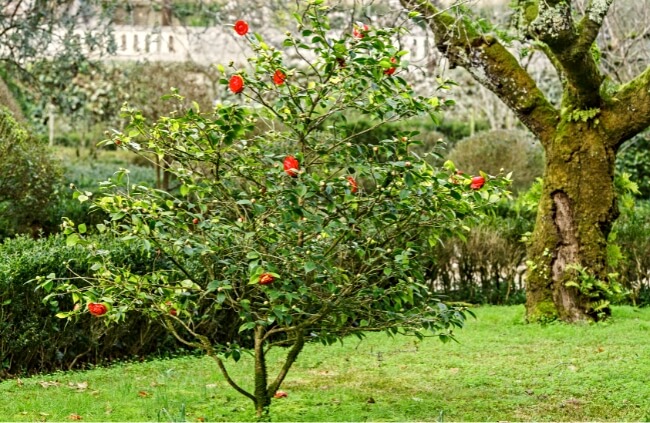
How big does Camellia japonica grow?
Camellia japonica can reach 10m tall if left completely unpruned, but it would require a very large space to do so. In most cases, Camellia japonica grows to 3-5m tall, and can even be pruned to a 1m high shrub if required.
Is Camellia japonica hardy?
Camellia japonica is completely frost-hardy. It does not like drought and should be watered well once a week during dry or hot weather. Keep the soil evenly moist throughout summer, but never soaking. In winter, camellia can dry out without any significant issues.
Can Camellia japonica be kept small?
You can keep Camellia japonica small, with many wonderful bonsai examples shared at garden festivals around the world each year. In more conventional gardens, camellia can be pruned annually or twice annually to maintain any size you need, whether its 50cm tall or 3m.
Does Camellia japonica grow fast?
Camellia japonica is slow-growing, usually growing 20-30cm each year at most. Despite being slow-growing, they are reliable, so will put on that growth every year until the end of time if kept alive.
What is the lifespan of Camellia japonica?
Camellia japonica are long-lived shrubs, or trees, depending on their treatment. The oldest known Camellia was planted in 1347 (nearly 700 years ago) in the Panlong Monastery in China.
Can Camellia japonica be left in pots?
Camellias grow well in pots and containers but do not need plenty of root space. Plant camellia in a pot about 20cm wider than its current root ball to allow its roots to spread, and ensure plenty of organic compost is mixed in to extend its stay in that container.
Should you deadhead Camellia japonica?
There is no benefit to Camellia japonica in deadheading. It will not trigger new flowers. However, faded camellia flowers, of all species, are messy, brown, and can turn to mush on the plant. Occasionally pulling dead blooms off the plant by hand will keep it looking tidy.
Can I plant Camellia japonica close to the house?
You can plant Camellia japonica right up against a house. Its roots are not invasive and will spread into the soil without interfering with brickwork or foundations. We have a forty-year-old Camellia japonica that was planted next to our front door and its roots grow under the driveway with no issues.
Does Camellia japonica like to be moved?
Camellia japonica doesn’t like to be moved during the growing season, especially not while flowering. While the plant is dormant in winter, you can move it anywhere you like and it will shoot up again in spring like nothing ever happened.
How many times does Camellia japonica bloom each year?
Flowering times can vary widely depending on where you live, but will always be between the end of autumn and mid-spring. In most cases, Camellia japonica blooms once a year, usually in early to mid-winter in most parts of Australia.
Grace Your Outdoors with the Exquisite Blooms of Camellia japonica
There is a flower shape and colour to suit every garden. From pollinator-friendly open flowers to showy doubles to please the most lavish of gardeners, camellias have so much to give to your garden.
Camellia japonica has always been one of my favourite garden shrubs. With so many cultivars to choose from there is no excuse to be without.
Camellia stands the test of time gracing our gardens and never really going out of favour.
Published on August 2, 2023 by AGT
Last Updated on September 20, 2024


